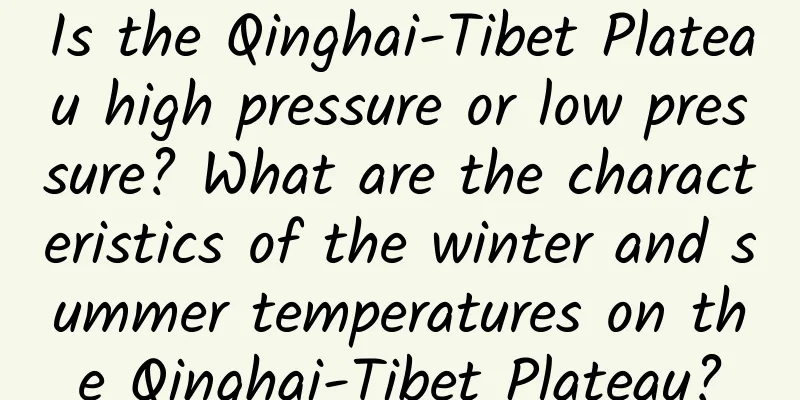Is the Qinghai-Tibet Plateau high pressure or low pressure? What are the characteristics of the winter and summer temperatures on the Qinghai-Tibet Plateau?

|
People feel chest tightness and difficulty breathing on the Qinghai-Tibet Plateau. Low air pressure on the plateau is only a basic reason. The main reason is that low air pressure makes the oxygen content in the air much lower than that in the plains, and even lower than the lower limit of oxygen content required by the human body. In this case, the human body cannot get enough oxygen and must make adjustments such as increasing breathing frequency, increasing lung capacity, etc. to meet the body's need for oxygen, which can easily cause altitude sickness. What are the characteristics of winter and summer temperatures on the Qinghai-Tibet Plateau? Let's take a look at the introduction of Encyclopedia Knowledge Network. Contents of this article 1. Is the Qinghai-Tibet Plateau high pressure or low pressure? 2. Is the Qinghai-Tibet Plateau the roof of the world? 3. What are the characteristics of winter and summer temperatures on the Qinghai-Tibet Plateau? 1Is the Qinghai-Tibet Plateau high pressure or low pressure?The Qinghai-Tibet Plateau is high in terrain, so the mass of the air column above it is smaller than that in the plains, which also makes the air pressure lower than that in the plains. People feel chest tightness and difficulty breathing on the Qinghai-Tibet Plateau. The low air pressure on the plateau is only a basic reason. The main reason is that the low air pressure makes the oxygen content in the air much lower than that in the plains, and even lower than the lower limit of oxygen content required by the human body. In this case, the human body cannot get enough oxygen and needs to make adjustments, such as increasing the breathing rate, increasing the lung capacity, etc. to meet the body's need for oxygen, which can easily cause altitude sickness. 2Is the Qinghai-Tibet Plateau the roof of the world?The Qinghai-Tibet Plateau is the roof of the world. It is the largest plateau in China and the highest in the world. It stretches from the southern edge of the Himalayas in the south to the northern edge of the Kunlun Mountains, the Altun Mountains and the Qilian Mountains in the north. The Pamir Plateau and the Karakoram Mountains are in the west, and the western section of the Qinling Mountains and the Loess Plateau in the east and northeast. It lies between 26°00′~39°47′ north latitude and 73°19~104°47′ east longitude. The Qinghai-Tibet Plateau is about 2,800 kilometers long from east to west and about 300 to 1,500 kilometers wide from north to south, with a total area of about 2.5 million square kilometers. It can be divided into six parts: the northern Tibetan Plateau, the southern Tibetan Valley, the Qaidam Basin, the Qilian Mountains, the Qinghai Plateau and the Sichuan-Tibet alpine canyon area. It includes all of Tibet in China and parts of Qinghai, Xinjiang, Gansu, Sichuan, Yunnan, as well as part or all of Bhutan, Nepal, India, Pakistan, Afghanistan, Tajikistan and Kyrgyzstan. 3What are the characteristics of winter and summer temperatures on the Qinghai-Tibet Plateau?The overall natural environment of the Qinghai-Tibet Plateau is characterized by high altitude and cold weather. Winter: The temperature is cold. The Qinghai-Tibet Plateau is a cold source in winter. The surrounding atmosphere transfers heat to the plateau ground-air system, with the largest amount in December and January. A cold high pressure is formed in the middle layer, and the cold air sinks, strengthening the East Asian winter monsoon. In winter, the cold area of the Qinghai-Tibet Plateau is biased towards the west. Summer: The temperature is cool. In summer, the Qinghai-Tibet Plateau is a powerful heat source, transferring heat to the surrounding atmosphere, with the largest amount in June and July. A thermal low pressure is formed on the ground, the air rises, and a warm high pressure is formed in the upper air, namely the Qinghai-Tibet High Pressure, which strengthens the southwest monsoon and the southeast monsoon. The warm area in summer is wide. |
>>: When is the orange season? The benefits and functions of green oranges
Recommend
What should we pay attention to when we have a flow of people?
It is sacred for women to be mothers, but if they...
What is the best way to quench your thirst in summer? Not iced cola, not water, but...
Summer is coming and the temperature is gradually...
What are the effects of dimethoate suppositories?
Bisoprolol suppository is a topical medication th...
Girls don't dare to do it because it's ugly
Life is more open nowadays, so many men and women...
What causes bloating in early pregnancy?
Many women report experiencing stomach bloating i...
How to wear underwear if you have small breasts
The choice of underwear has become a question in ...
Chinese Cereals and Oils Association "Love and save grain, start with me" popular science pictures and texts - the benefits of wheat germ are not just high protein, high fiber, high VE
Produced by: China Cereals and Oils Association S...
Can pregnant women eat yellow bean paste?
Pregnant women and their families are very aware ...
Post-operative care after breast lumpectomy
The disease symptoms that women often suffer from...
Do you need to use antibiotics immediately when you have Mycoplasma pneumoniae infection? Here comes the list of scientific rumors for October →
1. Does Mycoplasma pneumoniae infection require i...
Which topical contraceptive pill is the best?
When men and women are enjoying themselves, they ...
What are the symptoms of infertility?
Recently, many female friends in families have ex...
What's the matter with the brown color on the girl's underwear?
If there are some brown substances on a girl'...
Why does my pregnant belly feel hard and tight?
Many female friends will experience a hard and ti...









